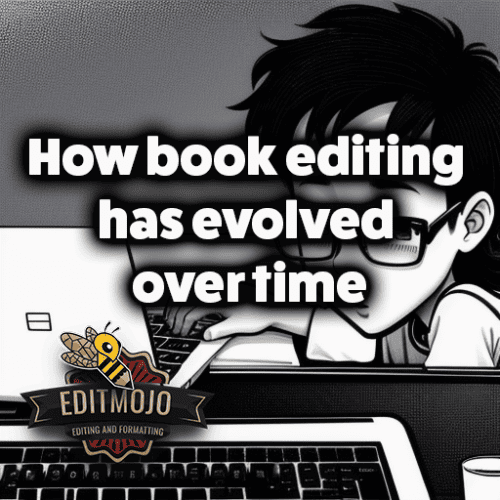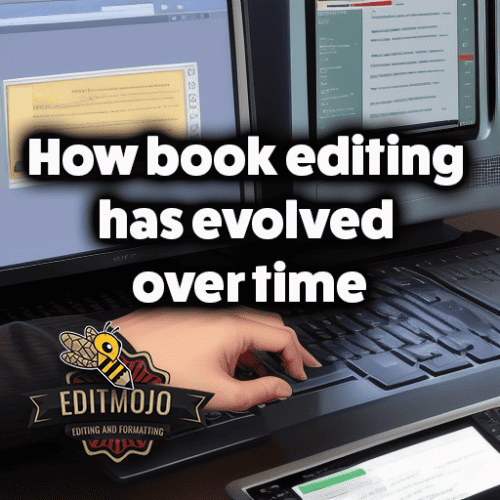How book editing has evolved over time
How book editing has evolved over time. The magic of a well-crafted book isn’t purely the work of the author; it’s a collaborative feat that involves a lesser-known hero—the book editor. The art and process of book editing have undergone a massive evolution over the years, adapting to cultural, technological, and industry changes. Let’s delve into the labyrinth of time to unravel the transformative journey of book editing.
Key Takeaways
| Time Period | Key Developments in Book Editing |
|---|---|
| Ancient Times & Middle Ages | Scribes and monks acting as early editors; Focus on transcription accuracy and standardization. |
| The Printing Press Revolution | Shift in role to more quality control and standardization; The role of editor starts to take a formal shape. |
| Modern Era | Role evolves from mere proofreading to creative collaboration; Maxwell Perkins helps shape literary classics; Technological innovations streamline the editing process. |
| Digital Age | Rise of self-publishing and AI-based tools; Remote editing becomes the norm; Emergence of freelance editing industry. |
| AI and Machine Learning | Advanced AI tools aid in stylistic improvements and readability checks; AI starts to impact the editorial process but can’t replace human understanding and creativity. |
| Future Trends | AI might offer advanced features like plot analysis; Editors may need to acquire new skills; Readers might take a more active role in the editing process. |
The Basics of Book Editing
Before we set off on our temporal expedition, let’s define book editing. Book editing involves enhancing and refining a manuscript, primarily focusing on aspects like structure, style, accuracy, and coherence. There are four broad types of editing:
- Developmental editing addresses the book’s structure and content.
- Line editing zeroes in on the use of language and style.
- Copyediting corrects grammar, punctuation, and syntax.
- Proofreading, the final stage, catches any remaining errors.
An editor is more than a manuscript’s quality control officer; they are the author’s ally, guiding the book from a rough manuscript to a polished masterpiece.

The Early Days of Book Editing
The Inception of Book Editing
Book editing, in its most rudimentary form, can be traced back to ancient civilizations. Scribes played the dual role of writer and editor, ensuring accurate transmission of texts. Despite no formal name for their editing process, their careful transcription and revision laid the foundations for modern editing practices.
The Middle Ages
During the Middle Ages, monks took up the mantle. As the primary literate demographic, they were responsible for transcribing and preserving texts. Their work often included adding comments, providing interpretations, or correcting textual errors—rudimentary editing actions.
The Printing Press Revolution
The advent of the Gutenberg printing press in the 15th century marked a significant shift in editing. With the rise of printed books, the role of human error in transcription decreased, but the need for standardization and quality control increased. Thus, the role of the editor started taking a more formal shape.
Notable Editors of the Classic Era
Editors like Ezra Pound, who extensively edited T.S Eliot’s “The Waste Land”, and Thomas Bowdler, famous (or infamous) for his ‘family-friendly’ version of Shakespeare’s works, had significant impacts on the texts we consider classics today.

The Evolution of Book Editing in the Modern Era
The 20th century marked a turning point in book editing, with its role evolving from mere proofreading and copy-editing to more involved, creative collaborations with authors.
The Shift in the Publishing Industry
The dichotomy between traditional and independent publishing drastically reshaped the editorial landscape. Traditional publishing maintained the stringent hierarchy of editors, while indie publishing gave rise to a spectrum of editorial roles, often filled by the authors themselves or freelance editors.
The 20th Century Editor
Editors of this era were no longer just gatekeepers of grammar and style. They began to help shape narratives and guide authors. Maxwell Perkins, the editor for giants like F. Scott Fitzgerald and Ernest Hemingway, was one such figure. Perkins didn’t just correct their grammar; he breathed life into their manuscripts, helping to shape the novels we cherish today.
Technological Innovations
The late 20th century brought word processors, spelling and grammar checkers. The floppy disk replaced the physical manuscript, making editing a more streamlined process. Microsoft Word’s “Track Changes” became a game-changer for real-time editing and collaboration.
Book Editing in the Digital Age
The dawn of the 21st century welcomed the rise of self-publishing, advanced software tools, and online collaboration, fundamentally changing the face of book editing.
The Rise of Self-Publishing
With platforms like Amazon Kindle Direct Publishing, authors could wear the editor’s hat. But this also led to an influx of poorly edited books, reinforcing the need for professional editing.
Evolution of Software Tools
The leap from simple spell-check to advanced AI-based tools like Grammarly and ProWritingAid revolutionized editing, making it faster and more efficient.
Online Collaboration and Freelance Editing
The internet dissolved geographic boundaries, making remote editing the norm. Platforms like UpWork and Freelancer led to the rise of the freelance editing industry, enabling editors to work with authors worldwide.

The Impact of AI and Machine Learning on Book Editing
AI and Machine Learning (ML) are no longer science fiction; they are making substantial inroads into language processing and, by extension, book editing.
AI Editing Tools (How book editing has evolved over time)
AI editing tools are not just about grammar and spell-check anymore. They can suggest stylistic improvements, check for consistency, and even assess readability. For instance, the Hemingway App offers suggestions for simpler alternatives to complex sentences, thereby improving the manuscript’s readability.
Case Study: AI in Editing Bestselling Novels
Some best-selling authors have embraced AI tools. For instance, Elle Griffin, a prolific novelist, used AI editing software for her debut novel, demonstrating how technology can help streamline the editing process.
Ethical Considerations (How book editing has evolved over time)
As AI penetrates the editing sphere, it’s crucial to address the associated ethical concerns. Will AI replace human editors? While AI can offer suggestions, the final decision still lies with the human editor, who brings an understanding of context, nuances, and creative insight that AI presently lacks.
Future Trends in Book Editing
Emerging technologies promise to reshape the editing landscape further, impacting the relationship between authors, editors, and readers.
Future of AI in Book Editing
As AI evolves, we might see more advanced features like plot analysis, character development suggestions, and theme consistency checks, further aiding the editor and the author.
The Changing Editorial Profession
With technological advancements, future editors may need to acquire new skill sets, like mastering AI tools and digital collaboration platforms.
The Reader’s Role
In the future, we might see readers taking up a more active role in the editing process—think beta reading on steroids—through platforms that facilitate crowd-sourced editing.
Conclusion (How book editing has evolved over time)
The journey of book editing, from the scribe’s table to AI algorithms, has been a testament to human creativity, adaptability, and the undying pursuit of literary excellence. Irrespective of the changes and advancements, the essence of book editing remains the same—refining the written word to communicate effectively and captivate readers. So here’s to the unsung heroes of the literary world—the editors—may they continue to adapt and thrive in their crucial role.
Top Five Questions and Answers
- Q: What are the four main types of book editing? A: The four main types of book editing are developmental editing, line editing, copyediting, and proofreading.
- Q: How did the printing press revolution impact book editing? A: The printing press decreased the role of human error in transcription but increased the need for standardization and quality control in texts, leading to the more formalized role of the editor.
- Q: What major change did the 20th century bring to the role of book editors? A: The 20th century saw the editor’s role evolve from mere proofreading and copy-editing to more involved, creative collaborations with authors.
- Q: How have AI and Machine Learning impacted book editing? A: AI and Machine Learning have led to advanced editing tools that not only check for grammar and spelling but can also suggest stylistic improvements, check for consistency, and assess readability.
- Q: What future trends are expected in book editing? A: Future trends might include more advanced AI features like plot analysis and theme consistency checks, changes in the editorial profession with editors needing to acquire new skills, and readers taking a more active role in the editing process through platforms that facilitate crowd-sourced editing.
